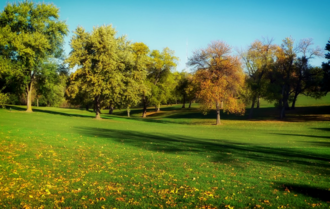- v50 information can now be added to pages in the main namespace. v0.47 information can still be found in the DF2014 namespace. See here for more details on the new versioning policy.
- Use this page to report any issues related to the migration.
Grass
v53.06 · v0.47.05 This article is about the current version of DF.Note that some content may still need to be updated. |
Grass is a type of plant found in any biome that supports vegetation and is necessary to feed grazing animals. Grass can grow on most above ground soil and tends to spread quickly, as can be observed by building a large dirt road in an outdoor area. As dwarves and other creatures walk over it, they have a chance (determined by the value of the [GRASSTRAMPLE] token) of eroding it down to the base soil, on which trees and plants cannot grow.
(e.g.: Elves have grasstrample 0. Dwarves have default grasstrample, which is 5. Dragons have grasstrample 50. Ergo, a mess of dwarves milling about your entrance will wear away all the grass, eventually, while a dragon does it with every step.) Grass erosion is also affected by grazing animals and fire.
Moss, fungi, and lichen, tiles similar to grass, appear in subterranean biomes; they will grow on underground soil and muddy floors after a cavern has been breached. Livestock feed on them like they do on normal grass.
Grazing[edit]
Livestock require a steady diet of grass in order to avoid starvation. As they eat, the grass is eroded as though it were trampled, gradually denuding and depopulating their pasture if it isn't large enough. As there are at most 4 bunches of grass per tile, grass that is consumed in the process of an animal's grazing means that the base layer of soil is revealed until the grass grows back. There is currently no known way of determining how many of the maximum 4 bunches of grass are present in any one tile.
Sand and clay[edit]
Grass growing on a soil floor of sand or clay will prevent the raw material from being collected for the glass or ceramic industries. If grass has grown on a collection activity zone, you can easily clear it by designating a dirt road (![]() b
b![]() n
n![]() O) on top of it. A floor grate or paved road (
O) on top of it. A floor grate or paved road (![]() b
b![]() n
n![]() o)can be placed over a collection activity zone to prevent grass from growing, while still allowing the raw material to be collected.
o)can be placed over a collection activity zone to prevent grass from growing, while still allowing the raw material to be collected.
Fire[edit]
Grass can also be destroyed by fire and magma. Creatures such as fire imps can shoot fireballs when attacking, and these can set the grass on fire. If grass ignites, the fire will slowly spread to all connected grass, generating smoke as it burns. Fire turns grass into ashes, but not usable ashes. Anything that is flammable and stands on burning grass (if you look at it, you will see "A fire") has a chance to catch fire each turn. Note that fire breath will also set grass on fire, as well as instantly turning it into ashes. Grassy slopes will not catch on fire, thus preventing the fire from spreading across z-levels solely via grass. Burning trees, however, can allow fire to make the jump between z-levels.
Variation[edit]
During a dry season, grass tiles on the screen change into dry grass tiles, but the effect is purely cosmetic.
In good biomes, you may find grass made up of bubbles and feathers acting just like regular grass for the livestock that eat it.
In evil biomes, you may find grass made up of wormy tendrils and staring eyeballs. Like their good counterparts, they feed livestock normally. Wormy tendrils tend to wiggle constantly and staring eyeballs will blink from time to time. In evil biomes that are also undead areas, much of the grass (sometimes even evil grass) is dead, like the trees. Animals will not eat the dead grass. Assign a larger area for pastures so grazers can eat the patchy still-living grass.
Some grasses have flowers that bloom in spring. These are baby toes succulent, cloudberry, cottongrass, marsh thistle, meadowsweet, mountain avens, pebble plant, and rush.
Relationship to real-world grasses[edit]
All "grass" types in the game, apart from the four special types found in evil and good biomes, are actual plants in the real world. The vast majority of them are also true grasses (this includes bamboo) or at least close relatives - rushes, sedges and cattail. The vegetation of some extreme biomes uses non-grass plants: mountain avens, mountain heather and cloudberry in mountains, baby toes succulent and pebble plant in deserts. Other notable exceptions are the marsh thistle, knotgrass and meadowsweet.
"Grass" in other Languages
|


